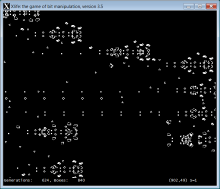Xlife
| Xlife | ||
| ||
| Homepage | Click here | |
|---|---|---|
| Purpose | Life simulation | |
| Created by | Jon Bennett | |
| Platform | X Window System | |
Xlife is a popular freeware Life simulation program that runs under the X Window System and was originally written for Unix workstations.
It was one of the first implementations of Life (@1989) to try something other than a naive approach, which results in it being able to handle large patterns on relatively modest computers, such as Bill Gosper's famous breeder. Xlife since version 4.0 (@1992) supports n-state rules and some Prisoner's Dilemma models—it was also one of the first in these fields.
Xlife has had an uneasy development history[1]. The first three versions were developed mainly by Jon Bennett at CMU. Chuck Silvers, Paul Callahan, Eric S. Raymond, and Achim Flammenkamp also participated in the development, and Daniel E. Lovinger was also involved during at least 1989-2005[2]. The most widespread version of xlife is 5.0; there are many variants of this updated for modern compilers. The longest xlife patches development history (1996-2009, 8 patches) was for a Debian Linux distribution. OpenBSD contains version 5.3 of xlife. The versions 6.x are released since 2011. They are based on Debian patched version 5.0 and OpenBSD version 5.3 of xlife.
Modern Xlife supports up to 256 states with Moore neighbourhood and generated rules. It also supports up to 64 states n-state rules. It allows to use different topologies. Xlife has several special modes (historical, pseudocolor, ...) for 2-state automata. It has several other unique features and is one of the fastest simulators available for several classes of cellular automata.
Most versions of Xlife also support a structured pattern format, "#I format", which remains one of the most efficient methods available for compactly encoding complex highly ordered Life patterns. An #I-format encoding of any large logic circuit or self-supporting spaceship, for example, tends to be smaller than the equivalent encoding in RLE, Golly macrocell format, or even the compressed RLE or compressed macrocell formats also supported by Golly.[3].
Xlife has been updated and ported for many different platforms. Xlife 3.5[4] has been ported to Windows, as has Xlife 2.0[5].
References
- ↑ a preliminary edition
- ↑ at Microsoft Blog
- ↑ Conway's Life: Work in Progress blog
- ↑ Xlife at David's web pages
- ↑ at Heriot-Watt University
External links
- Xlife at Linux software directory
- Xlife at the Life Lexicon
